Tonnarelli is a long square type of pasta made with eggs and semolina flour. It's a traditional homemade pasta from Molise and Abruzzo region. It can be served with variety of sauces but the most popular of them all is simple Tonarelli Cacio e Pepe.
In this recipe you’ll find step-by-step instructions with picture and all the tips & tricks to make delicious homemade tonnarelli, even if you’ve never made homemade pasta before. All you need is 2 simple ingredients and 2 pasta making tools.
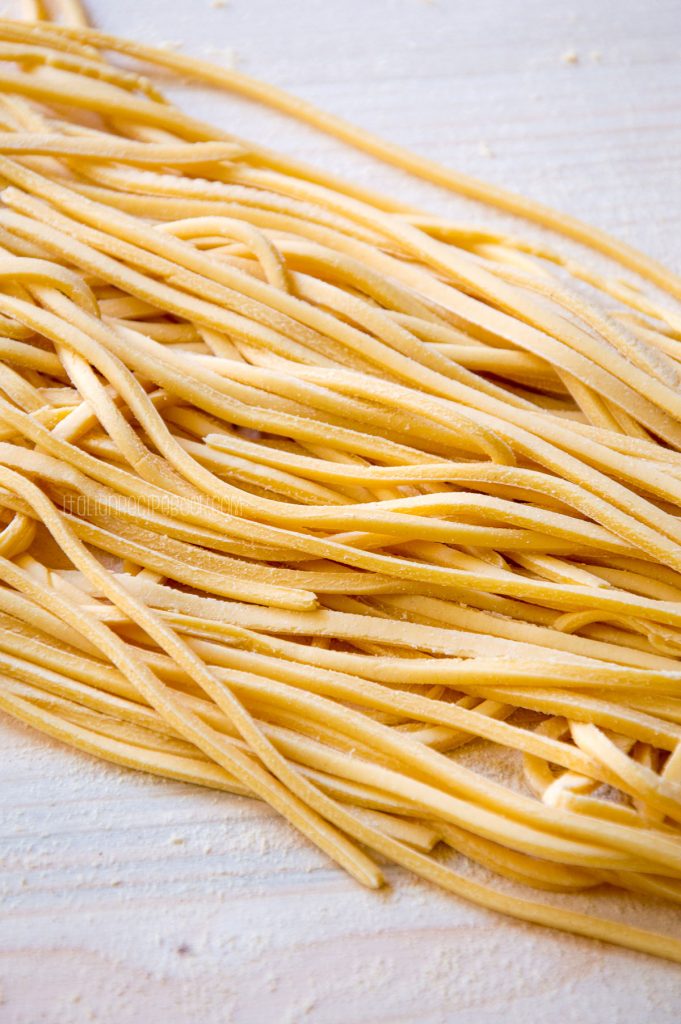
Table Of Contents
What Is Tonnarelli Pasta?
Tonnarelli is an egg pasta, which we could defined as some sort of thick (2-3 mm wide), square spaghetti with a rough texture. These characteristics are the ones that allow this kind of pasta to soak up robust sauces nicely and that differ it from “regular” spaghetti, which are smoother, and from bucatini, which have a hole running through their center.
Origins & Regional Versions Of Tonnarelli
The origins of this kind of pasta are quite obscure; what it is certain is only the area where we can find it, which is Lazio, the region of Rome. As it is always the case when talking about the Belpaese, there are specific versions and local variations on the theme and, in fact, we can list a whole bunch of recipes coming from the neighbour regions. In Abruzzo, for example, tonnarelli pasta is known with the name of spaghetti alla chitarra, whereas in Molise it is called maccheroni crioli or cirioli. In the Northern part of Apulia, in the area between Foggia and Gargano called Daunia, it takes the name of troccoli, a pasta type which differs from the previously mentioned versions for the instrument used to make it, which is, in this specific case, called troccolaturo.
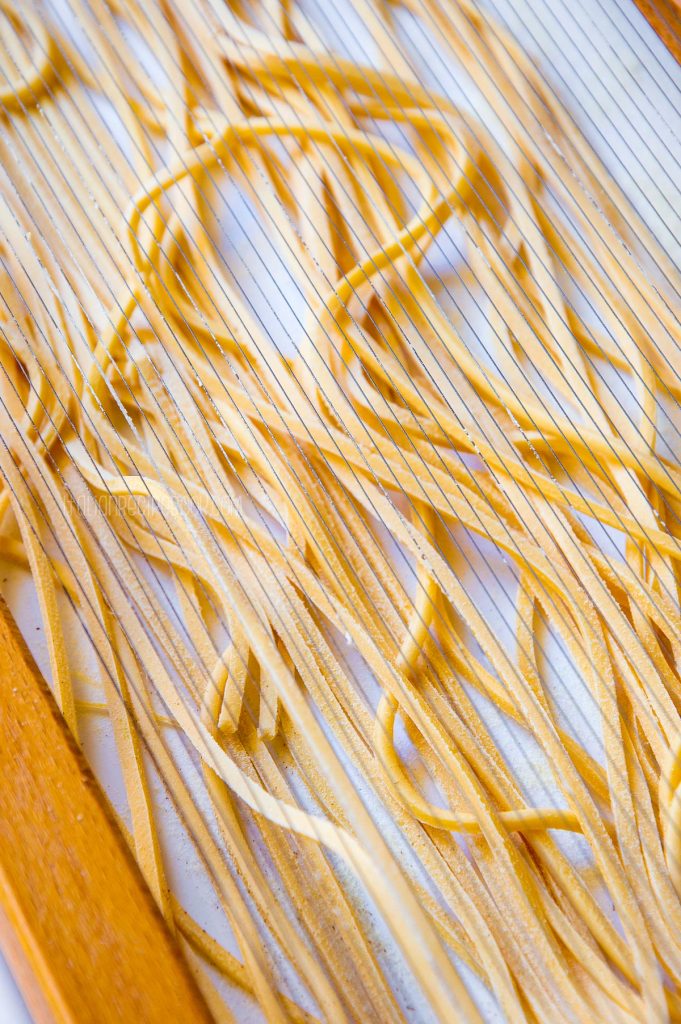
Ingredients
- Flour: Traditionally tonnarelli recipe calls for finely ground semolina flour or Italian “00” type flour. It’s a matter of personal preference and also depends on the sauce that you plan to cook your tonnarelli with.
As a rule of thumb, “00” flour will give a smoother and softer texture to pasta, while using semolina flour with give pasta an extra bite.
I figured that you’ll get the most delicious pasta in terms of taste and texture that pairs wonderfully with any sauce is by using half “00” flour (can be substitute with all-purpose) and half finely grounded semolina flour. Of course you can adjust these proportions to your personal preference. - Eggs: I recommend using large eggs or medium eggs plus a tablespoon or two of water. You can even skip eggs completely and make tonnarelli with eggless pasta dough as some people prefer. Use the recipe proportions like when you make Cavatelli Pasta.
- Salt: Like with all fresh pasta dough salt is optional. Some believe that adding salt will make the dough harder. Either way make sure to cook pasta in SALTED boiling water. If you haven’t added salt in the dough you’ll want water to bit a bit more salty than otherwise.
Also keep in mind the kind of sauce you’ll use with your pasta.
If you want to make classic Tonnarelli Cacio e Pepe beware that Pecorino cheese contains a fair amount of salt and you want your pasta to be just slightly salted.
Tools You'll Need
For the Apulia’s version of this pasta people use the troccolaturo, a rolling pin with notches. For tonnarelli and spaghetti alla chitarra the traditional tool is, as the name suggests, the chitarra pasta cutting tool, a tool made from strings stretched across a wooden frame that serves as a cutter and gives the tonnarelli its characteristic squared form.
The sheet of pasta is stretched on top of the “guitar” and then, with the use of a regular rolling pin, it is flattened against the strings. At this point, it is when the process of making pasta basically becomes playing music: by pulling the cords, the strings of pasta are created. It is, indeed, not by chance that the word chitarra, pronounced [kiˈtar.ra] means guitar in Italian!
How To Make Tonnarelli - Step By Step
Follow this step-by-step recipe to make tonnarelli (spaghetti alla chitarra) quickly and easily.
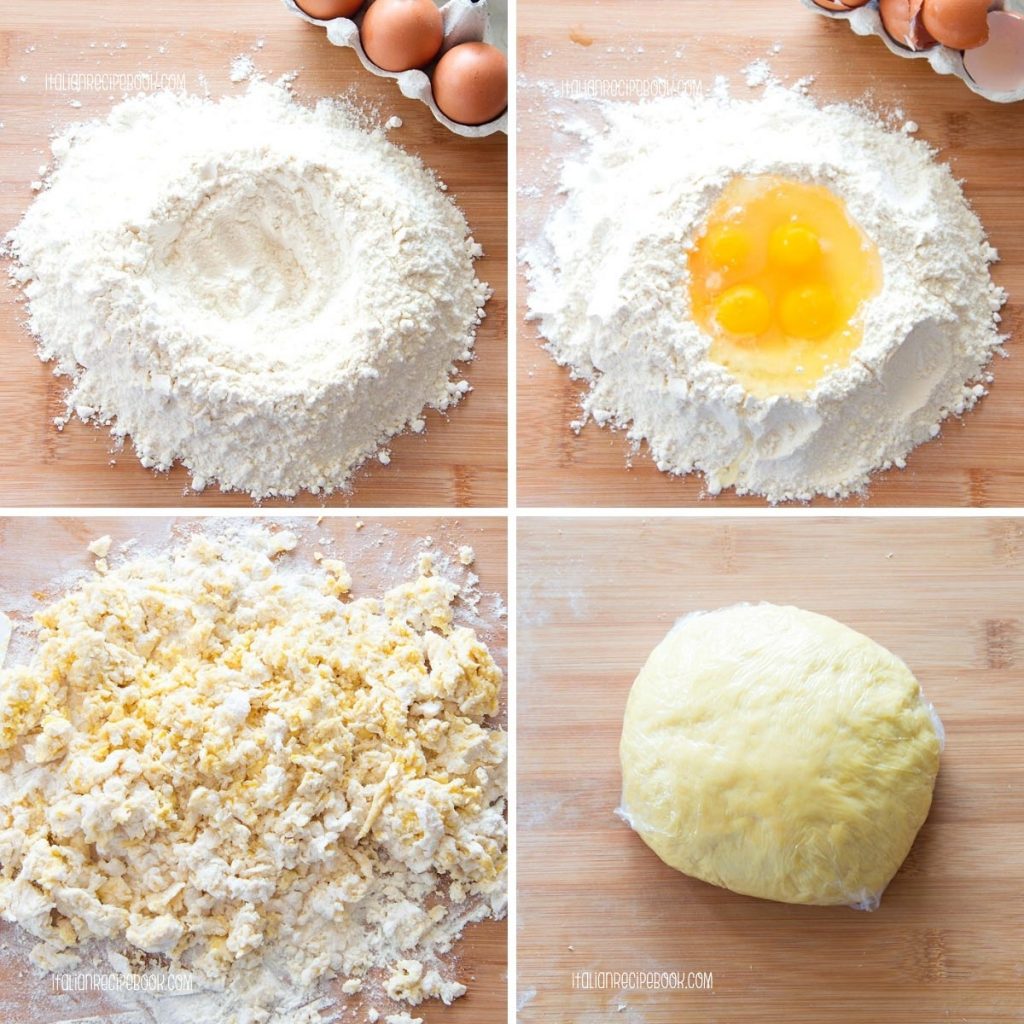
- Place flour in a mixing bowl or on a work-surface and make a well in the center.
- Add eggs and a pinch salt. Start beating the eggs with a fork, slowly incorporating the flour around them.
- Once the dough starts to be come too thick to work with a fork, flour your hands lightly and knead the dough on the work surface for about 10 minutes until it reaches a soft and smooth consistency.
- You can use your standing mixer to make the dough.
- Wrap it in a cling film and let it rest for about 30 minutes.
- Once the dough has rested, knead it a little more using your hands.
How to roll the dough using a rolling pin
- Cut the dough in 3-4 parts. Work with one dough piece at a time whiling keeping all other pieces of dough covered with a plastic wrap to prevent the dough from drying out.
- Roll out each piece of the dough with a rolling pin until you obtain sheets between 2-3 mm thick. Remember, the pasta should be as thick as the width between the pasta guitar strings in order to obtain the typical square shape.
When rolling pasta dough by hand it’s super handy to have this kind of rolling pin with adjustable thickness rings. As an alternative you can also get thickness rings for the rolling pin you already have, just to make sure to check if they fit the diameter of the rolling pin.
But even if you don’t have these, spaghetti alla chitarra (tonnarelli) are very forgiving. Just try your best to roll the dough as even as you can. - Lightly flour pasta sheets and arrange them apart on a worktop or on a large cutting board lightly dusted with flour and let pasta sheets dry for about 10 minutes. This is an important step that will prevent your pasta sheet sticking to the “pasta guitar”.
- Proceed in the same way with the remaining dough.
How to roll the dough using a pasta machine
If you have a pasta machine proceed in the following way once your dough is rested.
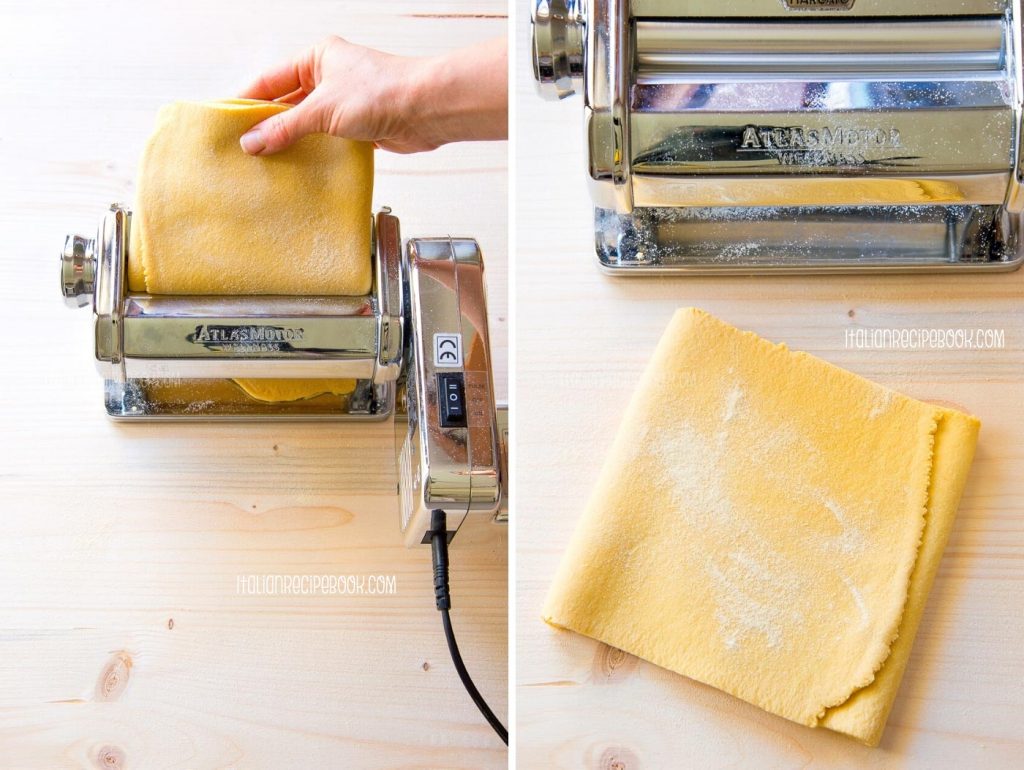
- Set your pasta machine on the widest setting (0) and pass the dough for the first time.
- Fold the dough in half (or 3 fold if needed) and pass again on the same setting.
- Adjust to the next-narrower setting, until you rich thickness of approx 2-3 mm.
I always work with Marcato Atlas Pasta Machine 150 and I use pasta machine setting #3 which corresponds to 2.4 mm thickness. You can read my detailed review and user guide for this made in Italy Pasta Machine here and why you absolutely need one if you like making homemade pasta (but not only!). - Dust pasta sheets with flour (or semolina) and let rest/dry for 10 minutes before proceeding to the next step.
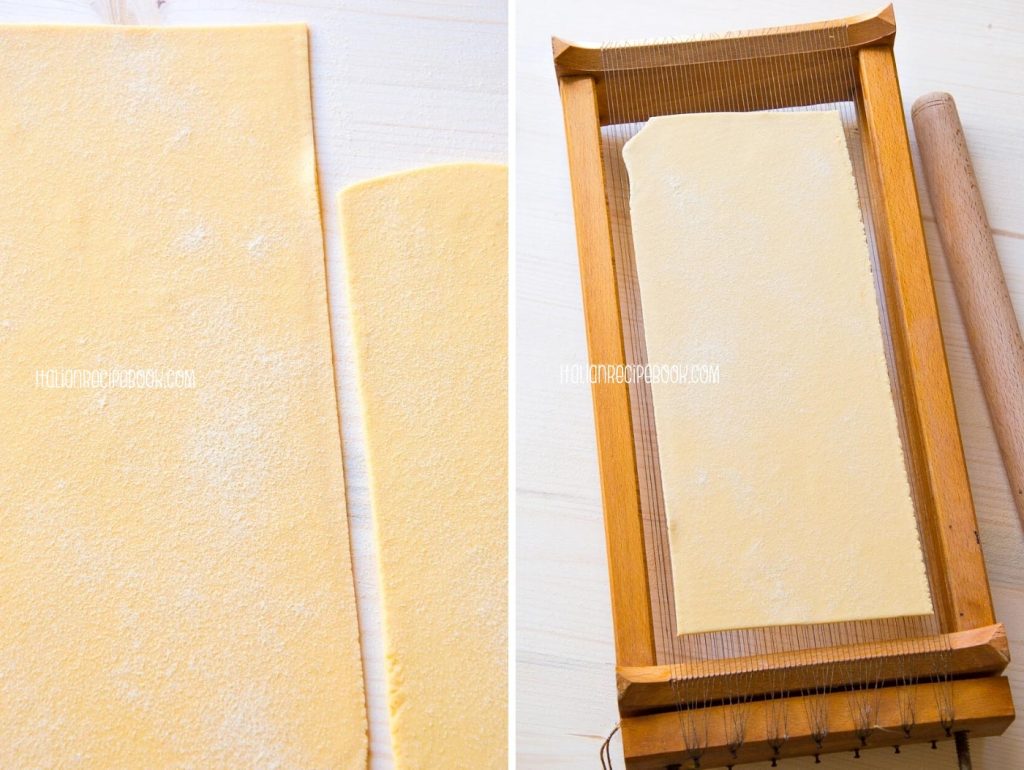
How to make Tonnarelli/Spaghetti Alla Chitarra using Chitarra Pasta Cutter
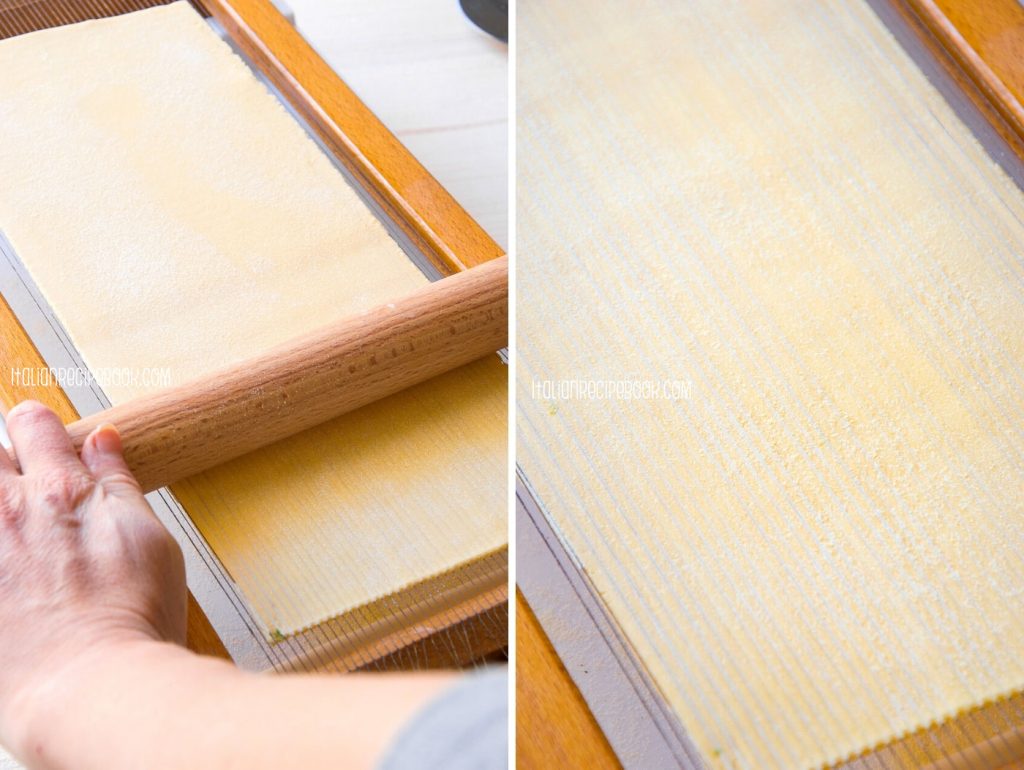
- Place a sheet of pasta on top of the chitarra and with the help of a rolling pin, flatten the pasta against the strings. With this process the dough will pass through but it’s also likely that it will cling in between the strings. In this case you simply have to run your fingers or a rounded knob of your rolling pin along the strings until they detach and fall into the tray underneath.
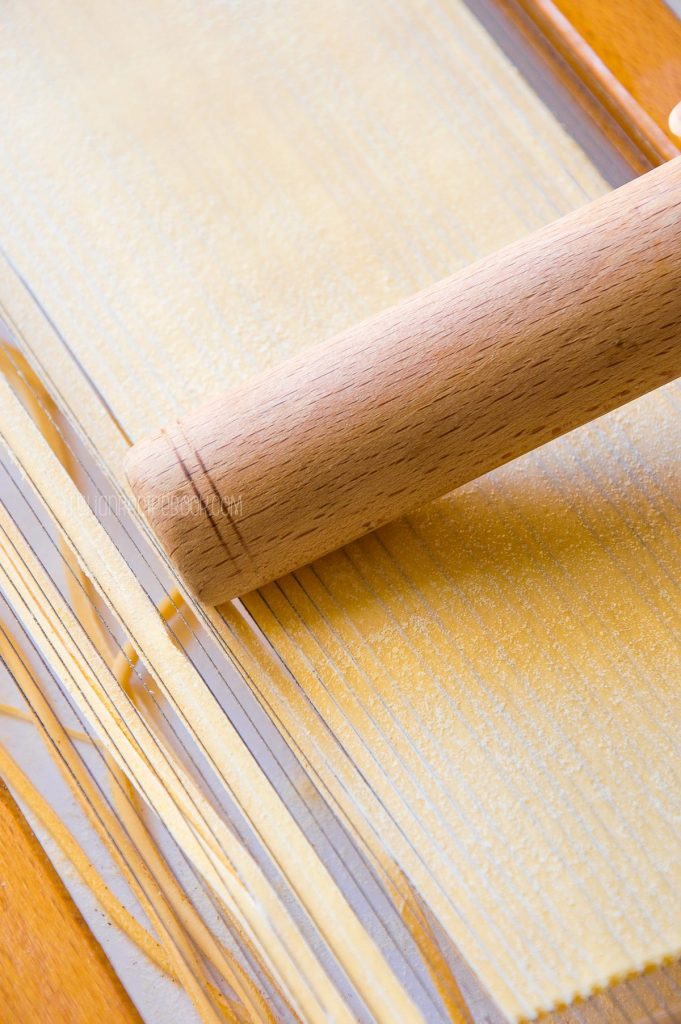
- Do this process with all pasta sheets you have.
- Cook tonnarelli al dente in slightly salted water considering eventual saltiness of the sauce and if you’ve added any in the pasta dough.
Tips & Tricks For Making Tonnarelli / Spaghetti Alla Chitarra
- Tonnarelli pasta should be as thick as the width between the pasta guitar strings in order to obtain the characteristic square form. If you’re not sure how thick you should roll pasta dough out, roll out and run a small piece of pasta through the chitarra and adjust accordingly.
- If your chitarra is double sided, use the size with narrower distance between the strings to make tonnarelli or spaghetti alla chitarra. You can use the side with wider distance between the strings to make tagliatelle. In this case you can roll pasta dough even thinner since you don’t need to keep it square shap.
- As needed you might want to tighten the strings of the chitarra with the tension screws.
- For even pasta thickness it’s handy to have this kind of rolling pin with adjustable thickness rings or use Pasta Machine.
- Lengthwise, it’s best to have pasta sheets an inch or 2 inches (3-5 cm) shorter than the length of the strings on the “pasta guitar” in order to leave some room for the pasta to stretch out as you press it through the stings.
- However if your pasta sheets happen to be a little longer, no worries. With a little bit of practice you’ll be able to flip a longer piece of pasta in the opposite direction and continue cutting spaghetti alla chitarra through the strings without braking them.
- If your Chitarra doesn’t have a container for pasta to fall into I highly suggest placing a small tray underneath.
- Since the tonnarelli are so thick, they take a little bit longer to cook. However, remember that this kind of pasta needs to be cooked al dente and it should be paired with robust and rich sauces.
Full Recipe
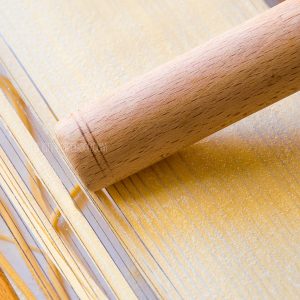
Tonnarelli Pasta From Scratch
Equipment
- Chitarra Pasta Cutter
- Rolling Pin
- Pasta Machine (optional)
Ingredients
- 300 g flour (see notes above)
- 3 eggs
- Pinch of salt (optional)
- More flour or semolina flour for dusting
Instructions
Fresh Pasta Dough
- Place flour in a mixing bowl or on a work surface and make a well in the center.
- Add eggs and a pinch salt. Start beating the eggs with a fork, slowly incorporating the flour around them.
- Once the dough starts to become too thick to work with a fork, flour your hands lightly and knead the dough on the work surface for about 10 minutes until it reaches a soft and smooth consistency.
- Wrap it in a cling film and let it rest for about 30 minutes.
- Once the dough has rested, knead it a little more using your hands.
How to roll the dough using a rolling pin
- Cut the dough in 3-4 parts. Work with one dough piece at a time whiling keeping all other pieces of dough covered with a plastic wrap to prevent the dough from drying out.
- Roll out each piece of the dough with a rolling pin until you obtain sheets between 2-3 mm thick. Remember, the pasta should be as thick as the width between the pasta guitar strings in order to obtain the typical square shape.
- Lightly flour pasta sheets and arrange them apart on a worktop or on a large cutting board lightly dusted with flour and let pasta sheets dry for about 10 minutes. This is an important step that will prevent your pasta sheet sticking to the “pasta guitar”.
- Proceed in the same way with the remaining dough.
How to roll the dough using a pasta machine
- Set your pasta machine on the widest setting (0) and pass the dough for the first time.
- Fold the dough in half (or 3 fold if needed) and pass again on the same setting.
- Adjust to the next-narrower setting, until you rich thickness of approx 2-3 mm.Thickness #3 on Marcato Atlas Pasta Machine 150.
How to make Tonnarelli/Spaghetti Alla Chitarra using Chitarra Pasta Cutter
- Place a sheet of pasta on top of the chitarra and with the help of a rolling pin, flatten the pasta against the strings. With this process the dough will pass through but it’s also likely that it will cling in between the strings. In this case you simply have to run your fingers or a rounded knob of your rolling pin along the strings until they detach and fall into the tray underneath.
- Do this process with the remaining pasta sheets.
- Cook tonnarelli al dente in slightly salted boiling water considering eventual saltiness of the sauce and if you’ve added any salt in the pasta dough.
Notes
- You can use your KitchneAid or standing mixer to make the dough.
- When rolling pasta dough by hand it’s super handy to have this kind of rolling pin with adjustable thickness rings. As an alternative you can also get thickness rings for the rolling pin you already have, just to make sure to check if they fit the diameter of the rolling pin.
Nutrition
Nutrition information is automatically calculated, so should only be used as an approximation.
Recipes With Tonnarelli
The traditional recipe from Lazio wants tonnarelli to be paired with cacio e pepe and/or a gricia sauce.
The recipes from Abruzzo and Molise call for the use of lamb, pork and beef-based ragù.
Less popular but still good pairings are the ones with wild boar and hare-based sauces.
The Molise and Abruzzo’s versions of tonnarelli are traditionally paired with the so-called sugo di pallottine, a tomato sauce with tiny beef-meatballs, giving birth to a dish called “chitarra alla teramana”. This is the recipe that most reminds the famous Italian-American dish “spaghetti and meatballs”, often mocked by Italians as “non-Italian” or not authentic.
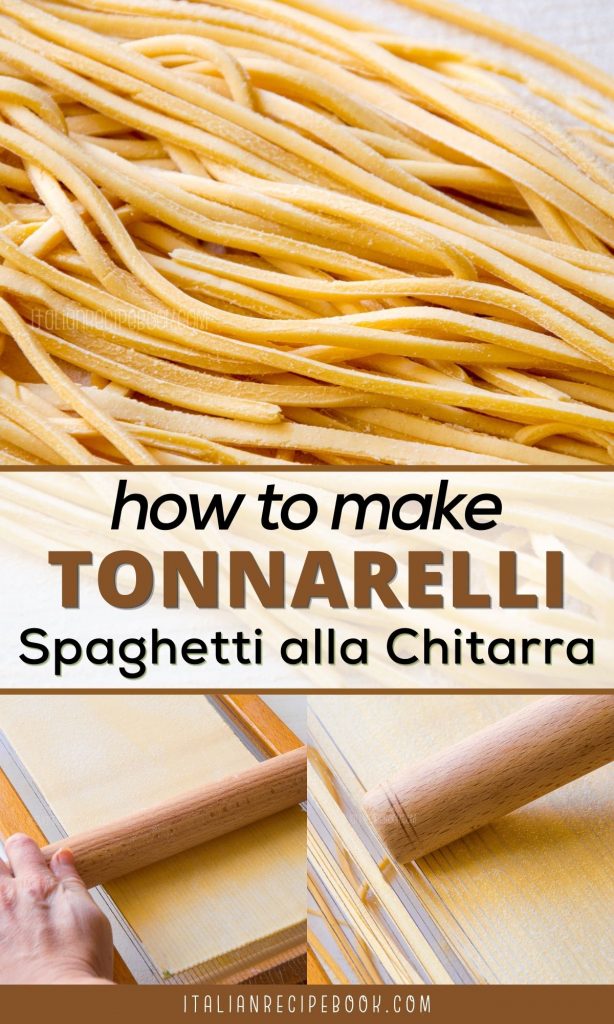

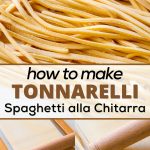
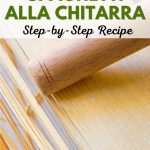
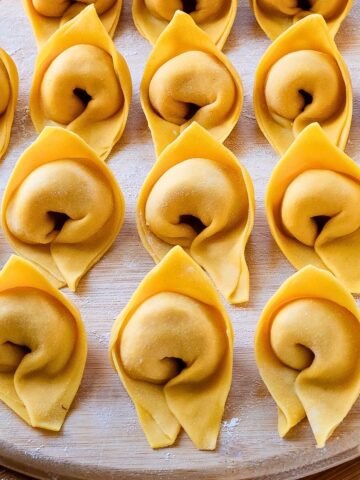
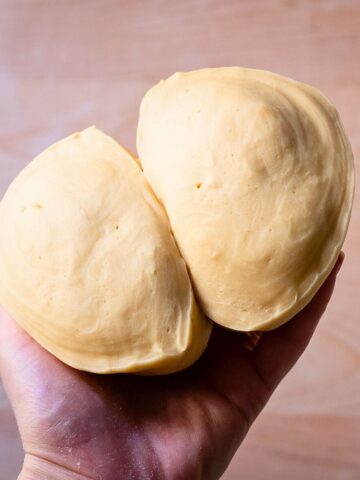
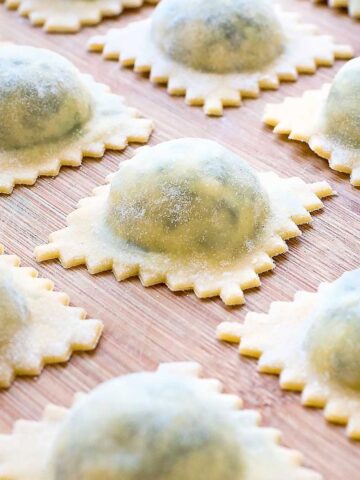

Annette W. says
Love your recipes and your website, but cannot find a contact page.....Is this the only way to get in touch ?
Best,
Annette
Italian Recipe Book says
Hello Annette, thank you! That's a good point, you can contact me at [email protected]